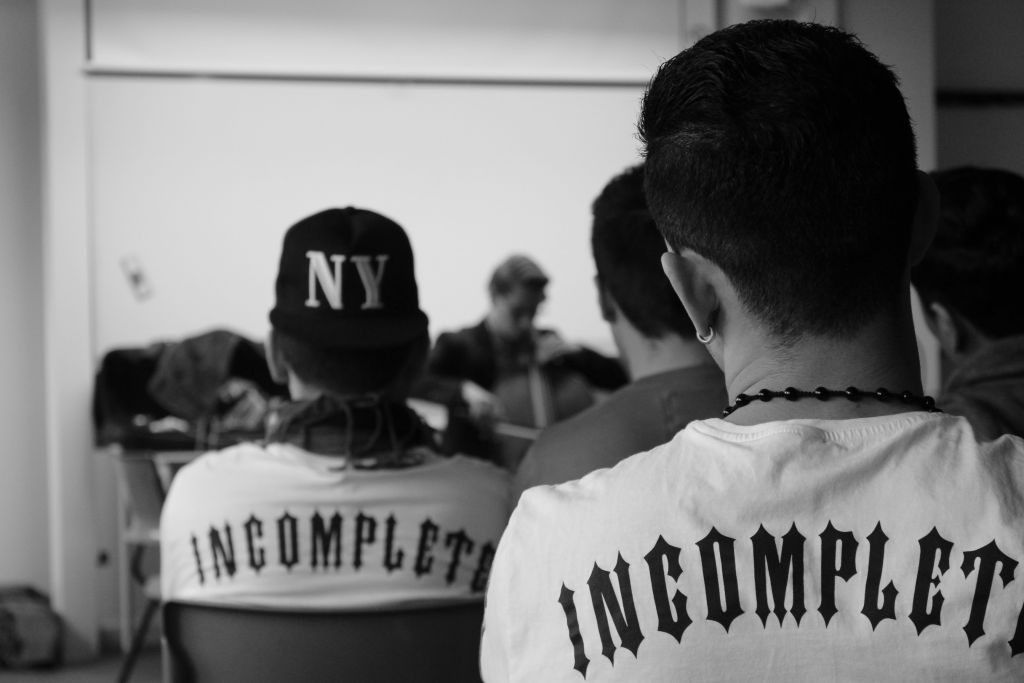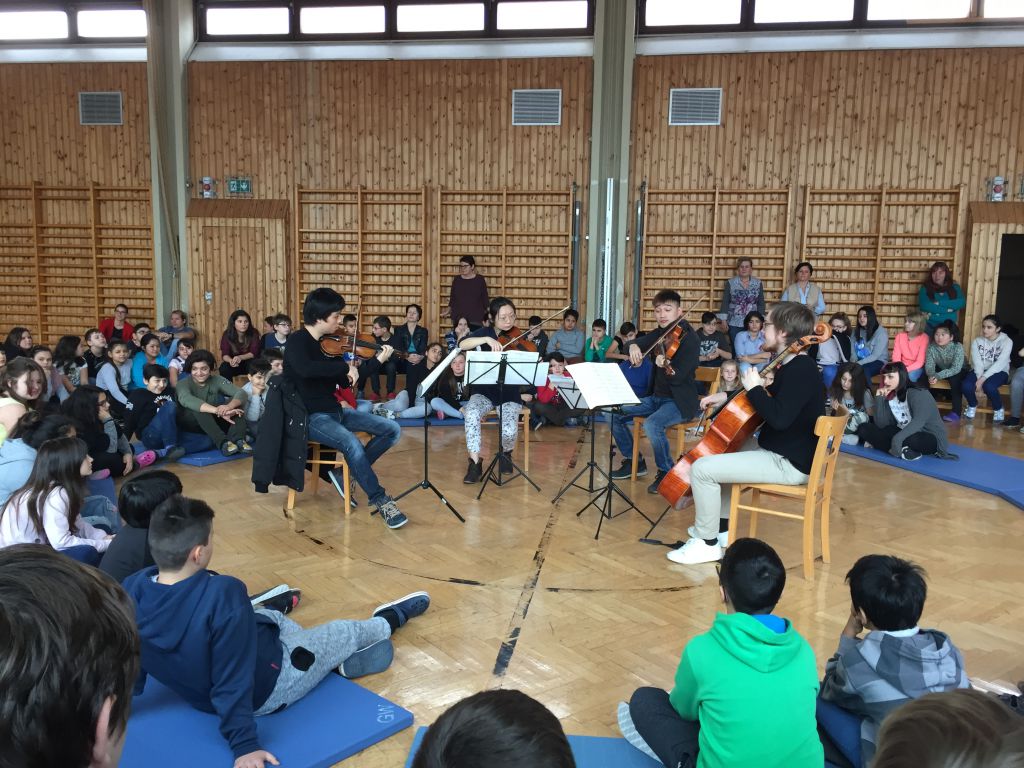Exzellenzausbildung und „Third Mission“ ideal vereint: Musethica verbindet intensives Auftrittstraining und niederschwellige Konzertangebote – mit wechselseitigen Benefits
Im Jahr 2012 hat sich eine Gruppe internationaler Lehrender am Konservatorium von Saragossa mit Professor_innen der dortigen Universität zusammengetan. Mithilfe öffentlicher und privater Unterstützung wurde das Projekt Musethica gestartet, das sich mittlerweile zu einem hoch aktiven Netzwerk mit Kooperationen in zahlreichen Ländern Europas und in Israel entwickelt hat. Der Hauptsitz der Organisation ist in Berlin, und es gibt für das ständig wachsende Projekt bereits in einigen Ländern eigenständige Vereine.
Vor etwas mehr als vier Jahren wurde ich von Avri Levitan, dem künstlerischen Leiter des Projekts, kontaktiert. Im Zuge erster eigener Erfahrungen mit dem Programm war ich dann so beeindruckt von der positiven Wirkung des Formats auf die Musiker_innen und die Menschen in den Institutionen, dass ich mich für eine nachhaltige Zusammenarbeit der mdw mit Musethica einzusetzen begann. Denn das Konzept ist bezwingend: Junge Musiker_innen brauchen für ihre künstlerische Entwicklung mehr professionelles Auftrittstraining als das Studium bieten kann, und es gibt so viel potenzielles Publikum, das aus den verschiedensten Gründen keinen Zugang zu erstklassigen Live-Aufführungen von klassischer Musik hat. Was liegt also näher, als diese beiden Bedürfnisse zu verbinden?
Den Menschen in den kooperierenden Institutionen (von „Problemschulen“, Einrichtungen für Drogensüchtige, Obdachlosenasylen, Hochsicherheitsgefängnissen, Hilfsstationen der Caritas bis zu Kinderkrebsstationen, Neonatologieabteilungen, Palliativabteilungen und Einrichtungen für Menschen mit schweren Beeinträchtigungen), die sich ihr Umfeld nicht ausgesucht haben, wird höchstklassige Leistung auf Augenhöhe geboten. Die Musiker_innen treten dabei nicht mit der potenziell herablassenden Attitüde auf, „diesen armen Menschen etwas Gutes zu tun“, sondern sie spielen jedes dieser Konzerte für ihr Publikum mit dem gleichen Respekt und dem gleichen Qualitätsanspruch, als wären sie auf der Bühne des Wiener Musikvereins oder der Carnegie Hall.

Um die Konzentration auf den künstlerischen Aspekt nicht zu stören, wird sogar die Information über die Institutionen vor den Konzerten bewusst auf das notwendigste Ausmaß reduziert. Selbstverständlich müssen die Musiker_innen aber mit den Bedingungen (wie meist nicht vorhandene Einspielräume) umgehen und die Regelungen der jeweiligen Institution respektieren. Wesentlich für den Erfolg des Programms sind professionelle Organisation und Coaching bzw. Mentoring, sowohl das Künstlerische als auch die Kommunikation mit dem Publikum betreffend.
Die kooperierenden Institutionen werden mit gründlicher Planung, genauen Absprachen und Begehungen im Vorfeld sorgfältig ausgewählt und auf die Auftritte vorbereitet. Musethica geht nirgendwo hin, wo es kein klares Commitment gibt oder gar die Gefahr bestünde, als unwillkommene Eindringlinge betrachtet zu werden. Eine Musethica-Intensivwoche umfasst für die Studierenden eine Vorbereitungsphase und dann zwischen zehn und 14 Auftritte in der Länge von 45 bis 60 Minuten. Unter Nutzung öffentlicher Verkehrsmittel wird darauf geachtet, dass die Institutionen gut erreichbar sind. Es können so pro Tag zwei bis drei Aufführungen stattfinden, und dabei bleibt auch Zeit für Coaching und Debriefing.
In einem typischen Musethica-Konzert werden nach einer kurzen Begrüßung und Vorstellung der Musiker_innen einzelne Sätze oder auch ganze Werke gespielt – mit Ansage der Werke und Komponist_innen, aber ohne nähere Erklärung zur Musik. Solistisches und Kammermusik von Duo bis Quintett oder Sextett wechseln einander dabei ab.
Jedes Mal kann man unmittelbar erleben, wie positiv die Menschen reagieren, wenn sie sich als vollwertiges Publikum ernstgenommen fühlen. Es gibt keine Arroganz gegenüber „Unwissenden“, und jede Beifallsäußerung jenseits gewohnter Konzertrituale wird akzeptiert. Die künstlerische Qualität muss stark sein, dann hören die Menschen mit Begeisterung zu, egal ob sie bereits mit dieser Musik in Kontakt gekommen sind oder nicht. Oft entsteht dann eine Atmosphäre wie bei einem Jazzkonzert, mit spontanen Beifallsbekundungen und sehr emotionalen Publikumsreaktionen während der Aufführung! Unmittelbar nach dem Konzert gibt es dann Raum für Gespräche und Fragen. Sehr oft entsteht dabei ein lebhafter Dialog bei Getränken und Snacks.
Obwohl weder Musikvermittlung noch Musiktherapie die obersten Zielsetzungen von Musethica sind, gibt es doch auch enorm positive Effekte in diesen Bereichen. So konnten in einer begleitenden medizinischen Studie in Schweden nachhaltige Schmerzlinderungseffekte bei Palliativpatient_innen nachgewiesen werden. Innerhalb des Musethica-Netzwerks gibt es daher immer mehr Zusammenarbeit mit Forschungsabteilungen von Universitäten, die messbare positive Auswirkungen in verschiedenen Bereichen untersuchen.

Nach bereits drei vom Joseph Haydn Institut organisierten Musethica-Wochen in Wien in den vergangenen zwei Jahren beginnt die mdw mit Unterstützung durch die Neumayer Stiftung aus Deutschland nun eine intensivierte Zusammenarbeit mit Musethica. Zukünftig wird es vier Musethica-Wochen pro Jahr geben, für die sich mdw-Studierende im Wahlfach bewerben können, im postgradualen Kammermusik-Lehrgang wird eine Musethica-Variante etabliert und für das Masterstudium Kammermusik soll ein Musethica-Schwerpunkt entstehen. Bereits in Vorbereitung sind auch begleitende Arbeiten von Studierenden des Instituts für Kulturmanagement und Gender Studies (IKM) und die Verbindung mit anderen Forschungsdisziplinen der mdw. Geplant ist auch eine Zusammenarbeit mit der Gemeinde Wien für niederschwellige Kulturprojekte an der Peripherie.
Mit Musethica etabliert die mdw somit einen weiteren wichtigen Baustein für die Verbindung von künstlerisch-pädagogischen Kernaufgaben mit „Third Mission“-Aktivitäten.
Weitere Informationen über Struktur, Aktivitäten und Zielsetzungen des Programms finden Sie unter musethica.org. Für die Durchführung an der mdw ist das Joseph Haydn Institut verantwortlich.

